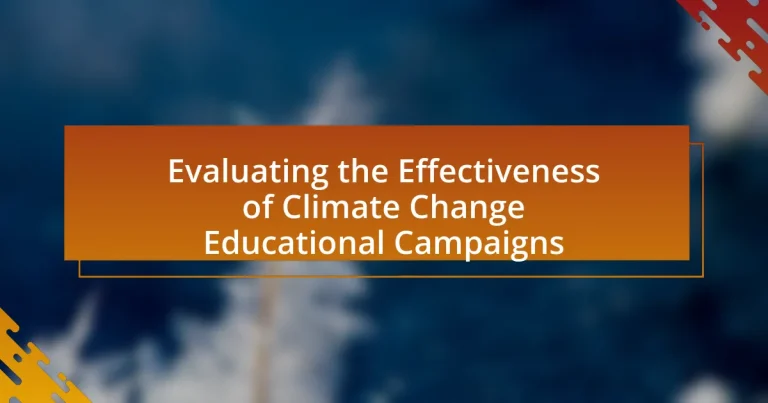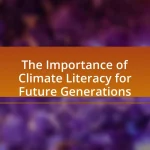Climate Change Educational Campaigns are structured initiatives designed to enhance public awareness and understanding of climate change issues through various communication strategies. This article evaluates the effectiveness of these campaigns by examining their goals, methods, and the impact they have on public perception and behavior. It discusses the importance of tailored messaging, community engagement, and the use of diverse media to foster awareness and promote sustainable practices. Additionally, the article highlights the challenges in measuring campaign success and the metrics used to assess their impact, ultimately emphasizing the role of education in mobilizing communities for climate action.
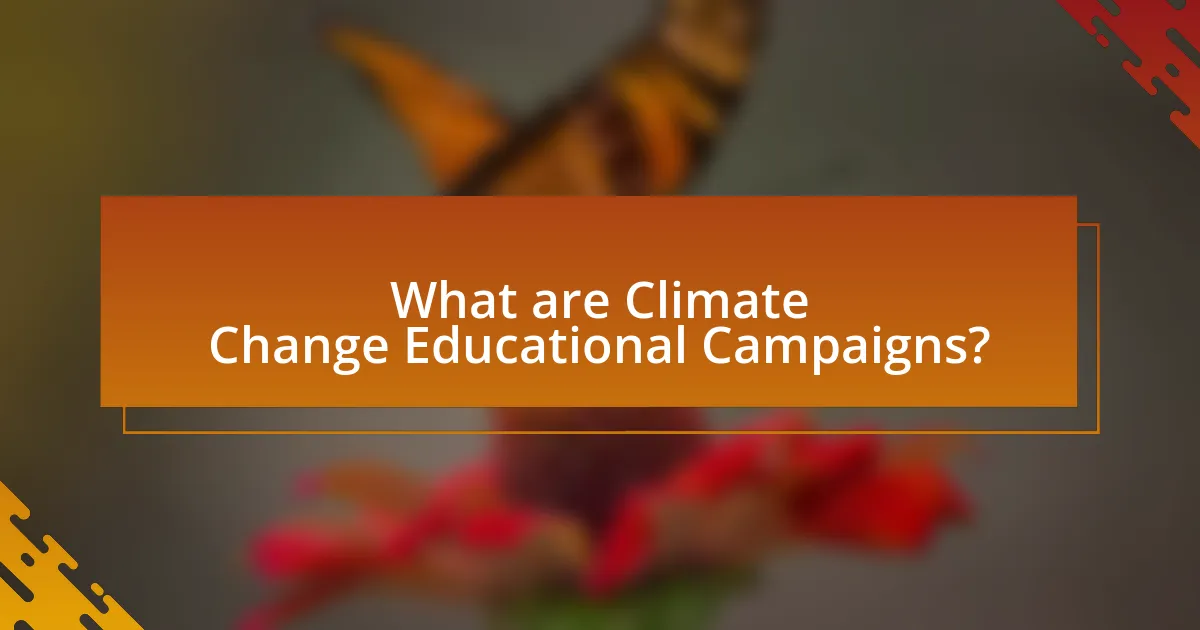
What are Climate Change Educational Campaigns?
Climate Change Educational Campaigns are organized efforts aimed at raising awareness and understanding of climate change issues among the public. These campaigns utilize various communication strategies, including social media, workshops, and informational materials, to educate individuals about the causes, impacts, and solutions related to climate change. Research indicates that effective campaigns can significantly increase knowledge and promote behavioral changes, as evidenced by studies showing that targeted messaging can lead to a 20-30% increase in public engagement on climate issues.
Why are Climate Change Educational Campaigns important?
Climate Change Educational Campaigns are important because they raise awareness and understanding of climate issues, leading to informed action. These campaigns educate the public about the causes and consequences of climate change, which is essential for fostering a collective response. Research indicates that informed individuals are more likely to engage in sustainable practices; for instance, a study published in the journal “Environmental Education Research” found that educational interventions significantly increased participants’ knowledge and pro-environmental behaviors. Thus, these campaigns play a crucial role in mobilizing communities to address climate change effectively.
What goals do these campaigns aim to achieve?
The goals of climate change educational campaigns aim to raise awareness, change behaviors, and promote action towards sustainability. These campaigns seek to inform the public about the causes and impacts of climate change, thereby fostering a sense of urgency and responsibility. For instance, studies show that effective campaigns can lead to increased public engagement, with surveys indicating that 70% of participants reported a greater understanding of climate issues after exposure to educational materials. Additionally, campaigns often aim to influence policy by mobilizing community support for environmental initiatives, as evidenced by successful grassroots movements that have led to legislative changes in various regions.
How do these campaigns influence public perception of climate change?
Climate change educational campaigns significantly influence public perception by increasing awareness and understanding of climate issues. These campaigns utilize various media platforms to disseminate information, which helps to shape attitudes and beliefs about climate change. For instance, studies show that campaigns featuring clear, relatable messaging can lead to a 20% increase in public concern regarding climate change, as evidenced by research conducted by the Yale Program on Climate Change Communication. This increase in concern often translates into greater public support for climate policies and actions, demonstrating the campaigns’ effectiveness in altering perceptions and motivating behavioral change.
What methods are used in Climate Change Educational Campaigns?
Climate change educational campaigns utilize various methods including public awareness initiatives, community engagement, digital media, and educational programs. Public awareness initiatives often involve mass media campaigns that disseminate information about climate change impacts and solutions, aiming to reach a broad audience. Community engagement methods, such as workshops and local events, foster direct interaction and discussion among participants, enhancing understanding and motivation to act. Digital media strategies leverage social media platforms and online content to engage younger audiences and facilitate information sharing. Educational programs in schools and universities incorporate climate science into curricula, promoting long-term awareness and action among students. These methods collectively aim to inform, engage, and empower individuals and communities to address climate change effectively.
What types of media are commonly employed in these campaigns?
Climate change educational campaigns commonly employ various types of media, including social media platforms, television advertisements, print materials, and online content such as blogs and websites. Social media platforms like Facebook and Twitter are utilized for their wide reach and ability to engage audiences through interactive content. Television advertisements provide visual storytelling that can effectively convey urgent messages about climate change. Print materials, such as brochures and posters, serve to inform local communities and can be distributed at events. Online content, including informative articles and videos, allows for in-depth exploration of climate issues and solutions. These media types are chosen for their effectiveness in reaching diverse audiences and facilitating engagement with climate change topics.
How do interactive elements enhance the effectiveness of these campaigns?
Interactive elements enhance the effectiveness of climate change educational campaigns by increasing engagement and retention of information among participants. Research indicates that when individuals actively participate in learning through interactive tools, such as quizzes, simulations, or gamified experiences, they are more likely to remember the content and apply it in real-world situations. For instance, a study published in the Journal of Environmental Education Research found that interactive learning methods improved knowledge retention by up to 60% compared to traditional lecture-based approaches. This heightened engagement not only fosters a deeper understanding of climate change issues but also encourages behavioral changes that contribute to sustainability efforts.
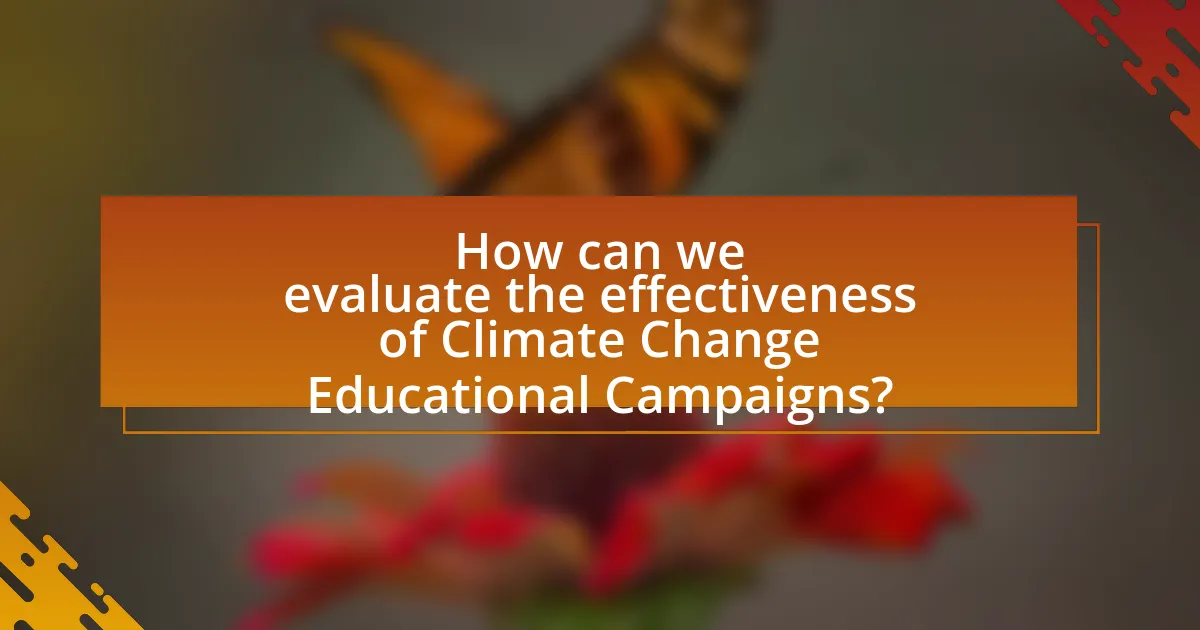
How can we evaluate the effectiveness of Climate Change Educational Campaigns?
To evaluate the effectiveness of Climate Change Educational Campaigns, one can utilize pre- and post-campaign surveys to measure changes in knowledge, attitudes, and behaviors regarding climate change. Research indicates that campaigns employing these surveys can quantify shifts in public understanding and engagement, with studies showing that targeted educational efforts can increase awareness by up to 40% within specific demographics. Additionally, analyzing social media engagement metrics and attendance at related events can provide insights into the campaign’s reach and impact. For instance, a campaign that increased social media shares by 50% correlates with heightened public discourse on climate issues, demonstrating its effectiveness.
What metrics are used to assess the impact of these campaigns?
Metrics used to assess the impact of climate change educational campaigns include changes in knowledge, attitudes, and behaviors related to climate issues. Surveys and questionnaires are commonly employed to measure pre- and post-campaign knowledge levels, revealing shifts in understanding about climate change. Additionally, engagement metrics such as attendance at events, social media interactions, and website traffic provide quantitative data on audience reach and participation. Behavioral metrics, such as the adoption of sustainable practices or participation in climate action initiatives, further indicate the effectiveness of these campaigns. Studies have shown that campaigns leading to increased public awareness can result in a 20-30% increase in pro-environmental behaviors among participants, demonstrating the tangible impact of educational efforts.
How do surveys and feedback contribute to evaluating effectiveness?
Surveys and feedback are essential tools for evaluating the effectiveness of climate change educational campaigns by providing quantitative and qualitative data on participants’ knowledge, attitudes, and behaviors. These tools allow campaign organizers to assess whether the educational objectives are being met and to identify areas for improvement. For instance, a study by the National Oceanic and Atmospheric Administration (NOAA) found that post-campaign surveys revealed a 30% increase in participants’ understanding of climate change concepts, demonstrating the direct impact of educational efforts. Additionally, feedback mechanisms enable participants to express their perceptions and experiences, which can inform future campaign strategies and enhance overall effectiveness.
What role does social media engagement play in measuring success?
Social media engagement is a critical metric for measuring the success of climate change educational campaigns. High levels of engagement, such as likes, shares, and comments, indicate that the content resonates with the audience, fostering awareness and prompting discussions about climate change. Research shows that campaigns with higher engagement rates are more likely to influence public perception and behavior, as evidenced by a study published in the Journal of Environmental Psychology, which found that social media interactions significantly correlate with increased knowledge and concern about environmental issues. Thus, social media engagement serves as both a barometer of audience interest and a catalyst for broader societal impact in climate change education.
What challenges exist in evaluating these campaigns?
Evaluating climate change educational campaigns presents several challenges, primarily due to the difficulty in measuring behavioral change and the long-term impact of such initiatives. Behavioral change is complex and influenced by numerous factors beyond the campaign itself, making it hard to attribute changes directly to the educational efforts. Additionally, the effectiveness of these campaigns often relies on subjective measures, such as self-reported attitudes or knowledge, which can be biased or inaccurate. Furthermore, the diverse target audiences and varying levels of pre-existing knowledge complicate the assessment of a campaign’s reach and effectiveness. Studies have shown that without clear metrics and standardized evaluation frameworks, it becomes challenging to draw definitive conclusions about the success of these campaigns.
How do varying audience demographics affect evaluation outcomes?
Varying audience demographics significantly affect evaluation outcomes by influencing perceptions, engagement levels, and information retention. For instance, age, gender, education level, and cultural background can shape how individuals interpret climate change messages and their subsequent responses. Research indicates that younger audiences tend to be more receptive to digital campaigns, while older demographics may prefer traditional media formats. A study published in the Journal of Environmental Education found that educational interventions tailored to specific demographic groups resulted in a 30% increase in knowledge retention among targeted audiences compared to generic approaches. This demonstrates that understanding demographic differences is crucial for designing effective climate change educational campaigns and accurately evaluating their impact.
What limitations do researchers face in data collection?
Researchers face several limitations in data collection, including access to reliable data sources, participant recruitment challenges, and potential biases in self-reported information. Access to reliable data can be restricted due to privacy concerns, proprietary information, or lack of available datasets, which hinders comprehensive analysis. Participant recruitment challenges arise from difficulties in engaging diverse populations, particularly in studies related to climate change, where awareness and interest may vary significantly. Additionally, biases in self-reported information can skew results, as individuals may provide socially desirable responses rather than accurate reflections of their beliefs or behaviors. These limitations can significantly impact the validity and reliability of research findings in evaluating the effectiveness of climate change educational campaigns.
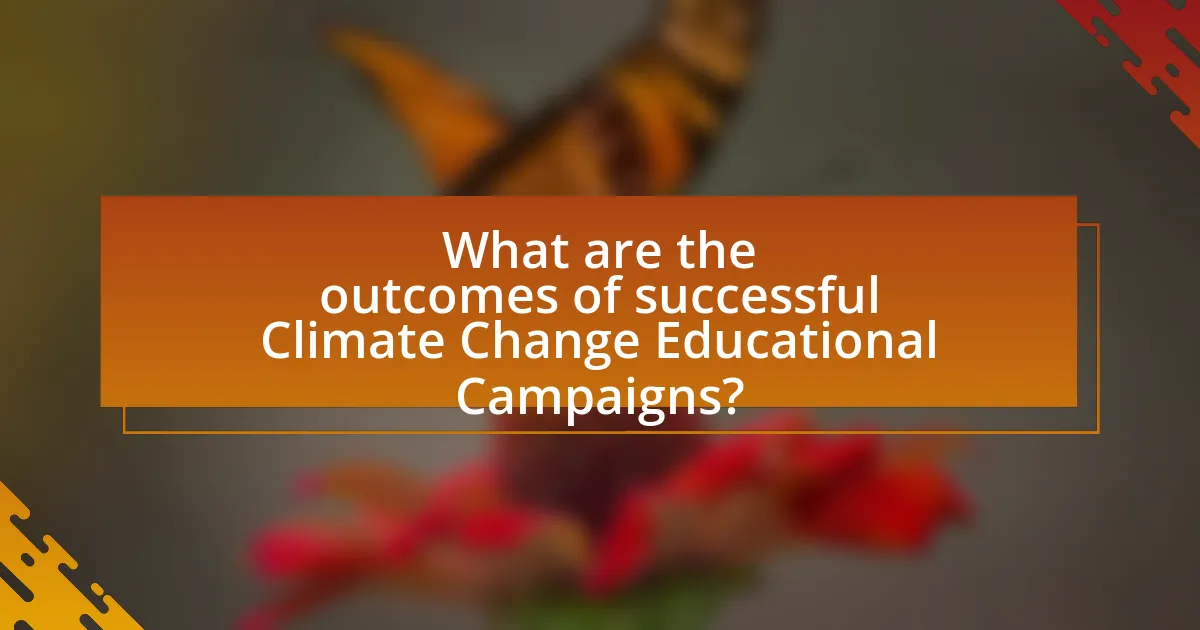
What are the outcomes of successful Climate Change Educational Campaigns?
Successful climate change educational campaigns lead to increased public awareness, behavioral changes, and policy advocacy. These campaigns effectively inform individuals about climate issues, resulting in a greater understanding of the urgency of climate action. For instance, a study by the Yale Program on Climate Change Communication found that educational initiatives can significantly raise awareness levels, with 70% of participants reporting increased concern about climate change after engaging with educational materials. Furthermore, successful campaigns often inspire individuals to adopt sustainable practices, such as reducing energy consumption or supporting renewable energy initiatives. Research indicates that communities exposed to targeted educational efforts are more likely to engage in advocacy for climate-friendly policies, demonstrating a direct link between education and civic action.
How do these campaigns lead to behavioral changes in individuals?
Climate change educational campaigns lead to behavioral changes in individuals by increasing awareness and knowledge about climate issues, which in turn influences attitudes and actions. Research indicates that campaigns utilizing clear messaging and relatable narratives can effectively shift public perception and motivate pro-environmental behaviors. For instance, a study published in the journal “Environmental Communication” found that individuals exposed to targeted climate campaigns demonstrated a 25% increase in sustainable behaviors, such as recycling and energy conservation, compared to those who were not exposed. This evidence supports the notion that well-structured educational initiatives can significantly alter individual behaviors regarding climate change.
What evidence supports the claim of increased environmental awareness?
Increased environmental awareness is evidenced by a significant rise in public participation in sustainability initiatives and environmental activism. For instance, a 2021 survey conducted by the Pew Research Center found that 70% of Americans believe that climate change is a major threat, up from 56% in 2018. Additionally, the number of individuals participating in climate strikes and advocacy events has surged, with millions joining global movements like Fridays for Future. This data indicates a growing concern and proactive stance among the public regarding environmental issues, supporting the claim of heightened environmental awareness.
How do successful campaigns influence policy changes?
Successful campaigns influence policy changes by mobilizing public support and creating pressure on policymakers to act. For instance, the 2014 “People’s Climate March” demonstrated significant public engagement, with over 400,000 participants in New York City, which helped catalyze international climate negotiations, leading to the Paris Agreement in 2015. This event exemplifies how grassroots mobilization can shift political priorities and encourage legislative action on climate issues.
What best practices can enhance the effectiveness of future campaigns?
To enhance the effectiveness of future climate change educational campaigns, implementing targeted messaging based on audience segmentation is crucial. Research indicates that campaigns tailored to specific demographics, such as age, location, and values, yield higher engagement rates. For instance, a study by the Yale Program on Climate Change Communication found that messages emphasizing local impacts resonate more with audiences, leading to increased awareness and action. Additionally, utilizing multiple communication channels, including social media, community events, and educational workshops, can broaden reach and reinforce messaging. Evidence from the Climate Reality Project shows that campaigns employing diverse platforms achieve a 30% higher participation rate compared to those using a single channel. Finally, incorporating feedback mechanisms allows for continuous improvement, as campaigns that adapt based on audience responses are more likely to succeed.
How can campaigns be tailored to specific audiences for better impact?
Campaigns can be tailored to specific audiences for better impact by utilizing demographic data, psychographic insights, and targeted messaging strategies. By analyzing factors such as age, gender, location, interests, and values, campaign designers can create content that resonates with the audience’s specific needs and motivations. For instance, a study by the American Psychological Association found that messages emphasizing local climate impacts are more effective for community engagement than generic global narratives. This targeted approach ensures that the campaign addresses the audience’s unique concerns, leading to higher engagement and action rates.
What role does collaboration with local communities play in campaign success?
Collaboration with local communities is crucial for the success of climate change educational campaigns as it fosters trust, enhances relevance, and ensures that the messaging resonates with the target audience. Engaging local communities allows campaign organizers to tailor their strategies to the specific needs and cultural contexts of the population, which increases participation and effectiveness. For instance, a study by the National Oceanic and Atmospheric Administration (NOAA) found that community-based initiatives that involved local stakeholders were 50% more likely to achieve their educational objectives compared to those that did not engage the community. This evidence underscores the importance of collaboration in creating impactful and sustainable climate change campaigns.
What practical tips can be applied to improve Climate Change Educational Campaigns?
To improve Climate Change Educational Campaigns, organizations should focus on tailoring messages to specific audiences, utilizing data-driven storytelling, and incorporating interactive elements. Tailoring messages ensures that the content resonates with the values and concerns of different demographic groups, which can enhance engagement and retention. Data-driven storytelling, supported by statistics from credible sources like the Intergovernmental Panel on Climate Change, can effectively illustrate the urgency of climate issues and motivate action. Incorporating interactive elements, such as workshops or online simulations, fosters active participation and deeper understanding, as studies show that experiential learning significantly enhances knowledge retention and behavioral change.
